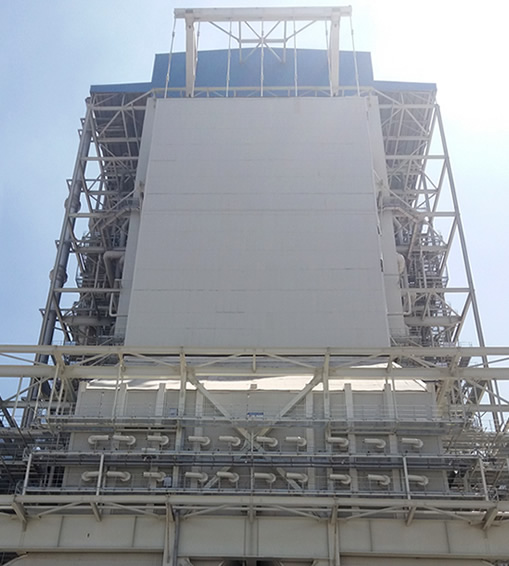Products & Services > Environment-friendly products
Environment-friendly products

Flue Gas Denitration Technology
Technology Description:
The environment-friendly denitration technology of Harbin Boiler Corporation (HBC) mainly includes low nitrogen burner (LNB) technology, selective non catalytic reduction (SNCR) technology and selective catalytic reduction (SCR) technology. The LNB and SNCR technologies have lower denitration efficiency (<50%), thus being very difficult to meet the increasingly stringent requirements of environmental protection. While SCR’s denitration efficiency can reach more than 90%.Being introduced from Mitsubishi Electric Corporation, SCR technology is widely used in international and domestic thermal power plants.
1. HBC Patented Technology — rectification grid
· Sufficient height to ensure the rectification effect
· Special neck structure to make installation and maintenance convenient
2. Optimized design of supporting beam of catalyst
· Take multi-supporting and hanging structure of catalyst to ensure the smoothness of catalyst surface and prevent the catalyst extrusion deformation caused by the support beam deformation after long-term operation
3. Catalyst layout
· Catalyst is normally laid out in 2+1 layers, with two layers being preliminarily installed and 1 layer being reserved.
4. Catalyst flue gas sealing structure
· Use the lower seal structure to prevent the flue gas sneakage.
5. Ammonia injection grid
· Inject the ammonia in a combination of long and short tubes and reduce static header pressures to ensure a uniform ammonia ejection in the depth direction of the flue.

Flue Gas Desulfurization Technology
ALSTOM Limestone- Gypsum Wet Flue Gas Desulfurization Technology
Technology features:
Mature and reliable technology; FGD process calculation method was formed based on ALSTOM engineering experiences to ensure the correctness of process design performance and equipment selection
· The single tower gas processing capacity is large with high SO2 removal efficiency
· Strong adaptability to fuel and boiler load changes
· Comprehensive utilization for the desulfurization by-products (gypsum)
The self-adaptive efficient sieve plate dusting and desulfurization technology jointly developed by Zhejiang University and HBC.
· Based on limestone-gypsum WFGD technology, HBC add the adaptive sieve plate mass transfer component and reasonably reduce the height position of the partition plate, so as to form a stable and uniform liquid layer.
· Optimize the opening rate, and strengthen the flue gas penetration. The mass transfer effect of the liquid holding layer improves the desulfurization efficiency and the dust removal efficiency.
· In addition to the top layer, the use of two-way nozzle can make the spray intensity more. Effectively reduce the flue gas sneakage.
· Take the low flue gas flow rate to lower down the mist-drop carryover.
· Rationally select flue gas inlet angle and uniform the flow distribution.
· Install anti-shortcut ring to effectively prevent the sneakage of the flue gas along the wall.
· Co-benefit processing PM ability in the adaptive sieve plate tower: the general removal efficiency of adaptive type tower plate was not lower than 80%.

Flue Gas Dust Removal Technology
Electrostatic-fabric filter precipitator:
· It is the combination of electric precipitator and bag filter. The front electrostatic precipitation area features high-efficiency dust removal. It can collect most dust in the flue gas and reduce the density of the dust that will go into the back bag filter. The dust leftover goes into the filter bag to remove tiny dust particles. In general, it can reach more than 99.9% efficiency, with perfect performance.
Wet electrostatic precipitator (WESP) technology of Mitsubishi
(1) Corona discharge to cause ionization of gas molecules
(2) Dust particle charging
(3) Dust collected by collecting plate
(4) Using flushing water to remove dust
Features
Selection of appropriate electrode material according to engineering experiences· The optimization of the nozzle structure and layout
· The optimization of inner flow field
· Simple ash water system is simple, and reduction of water consumption by sending wastewater into the desulfurization water system
· An installation way of fixing at the top and limiting the position at the bottom

Flue Gas Collaborative Treatment Technology
It is used to remove more than 2 kinds of flue gas pollutants in one device at the same time, or provide positive conditions for pollutant removal in the next process, to realize co-beneficial removal of multi-pollutants from flue gas in a high-efficiency and power saving way.
Pollutant emission levels: PM <5mg/Nm3, SO2 <35mg/Nm3 NOx<50mg/Nm3
Technical features:
· Collaboratively control multiple gas pollutants
· Remove SO3 and prevent purple smoke
· Reduce water consumption due to less evaporable water
· Downsize desulfurization system and circulating pump head
· Use heat recovery system to improve the efficiency of power generation
· Give full play to the dual role of desulfurization and dust removal
Technology Advantages:
· The layout of the whole system is designed scientifically, with much floor space being saved.
· System parameters are matched and optimized to enhance the whole efficiency.
· Procurement is made in a centralized way and materials are efficiently used to lower the total cost of the project.
· More scientific construction management and more reliable quality control.
· Coordinated management over each system to reduce operating costs.

